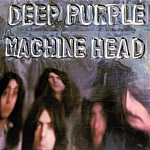Timeline : Deep Purple
Jon Lord, keyboard player for Deep Purple and Whitesnake, is born in Leicester, England.
Guitarist Ritchie Blackmore (of Deep Purple, Rainbow, Blackmore's Night) is born in Weston-super-Mare, Somerset, England.
Deep Purple lead singer Ian Gillan is born in Chiswick, London, England.
Deep Purple bass player Roger Glover is born in Wales.
Nick Simper, the original bass player in Deep Purple, is born in Middlesex, England.
Original Deep Purple lead singer Rod Evans is born in Buckinghamshire, England.
Ian Paice, Deep Purple's drummer and founding member, is born in Nottingham, England.
Guitarist Tommy Bolin (of Deep Purple and the James Gang) is born in Sioux City, Iowa.
David Coverdale is born in Saltburn-by-the-Sea, Redcar and Cleveland, England. After fronting Deep Purple from 1973-1976, he forms his own band, Whitesnake, in 1978.
Rock bassist/vocalist Glenn Hughes (of Deep Purple) is born in Cannock, Staffordshire, England. He has a brief stint as Black Sabbath's frontman in the mid-'80s.
Guitarist Steve Morse is born in Hamilton, Ohio. After forming The Dixie Dregs, he joins Deep Purple in 1994.
Nino Tempo and April Stevens' "Deep Purple" hits #1 in the US. The famous band later name themselves after the song.
Deep Purple make their stage debut at the Vestpoppen, in Kastrup, Denmark.
Deep Purple record "Hey Bop A Re Bop" at the BBC; this alternative version of "The Painter" is not released until 2000 on the Remastered The Book Of Taliesyn.
Deep Purple record "Speed King" in Studio 2 at the Aeolin Hall. It is aired six days later on Symonds On Sunday.
At Royal Albert Hall in London, Deep Purple play their Concerto for Group and Orchestra, written by their keyboard player Jon Lord, with the Royal Philharmonic Orchestra. In December, it is released as a live album.
Deep Purple write "Highway Star" on the way to show in Portsmouth, UK, where they play it that night.
Deep Purple record the track to "Smoke On The Water" at a Montreux nightclub called the Pavilion, where they've been relocated after the Montreux Casino, where they planned to record, burned down. They get kicked out the next day because of noise complaints and complete the Machine Head album at their hotel, using the Rolling Stones' mobile unit to record.
 During a Frank Zappa concert, the Montreux Casino in Switzerland catches fire when someone fires a flare gun, inspiring Deep Purple's "Smoke On The Water." Deep Purple are there to record their album Machine Head the following day, but end up using the Grand Hotel and including the song as a last-minute addition.More
During a Frank Zappa concert, the Montreux Casino in Switzerland catches fire when someone fires a flare gun, inspiring Deep Purple's "Smoke On The Water." Deep Purple are there to record their album Machine Head the following day, but end up using the Grand Hotel and including the song as a last-minute addition.More
Deep Purple arrive in Montreux, Switzerland to record their Machine Head album at the Montreux Casino. It doesn't go as planned: The casino burns down the next day and they end up recording in a hotel using the Rolling Stones' mobile unit. They tell the tale in the song "Smoke On The Water."
 Deep Purple's album Machine Head is released in America. Most of it was recorded in their hotel after the Montreux Casino, where they planned to record it, burned down, a story told in the song "Smoke On The Water."More
Deep Purple's album Machine Head is released in America. Most of it was recorded in their hotel after the Montreux Casino, where they planned to record it, burned down, a story told in the song "Smoke On The Water."More
Deep Purple "Mark II," the most famous incarnation of the band, comes to an end after a show in Osaka, Japan, with lead singer Ian Gillan abruptly quitting the group. Bassist Roger Glover leaves soon after; for "Mark III," they're replaced by David Coverdale and Glenn Hughes.
Deep Purple release "Smoke On The Water" as a single in America. The song, considered an add-on to fill space on the album, first appeared in March 1972 on Machine Head. By this time, lead singer Ian Gillan has quit the band.
Deep Purple release Burn, their first album with the Mark III lineup of the band, featuring David Coverdale as lead singer.
The Eagles, Earth, Wind & Fire, Black Sabbath, Deep Purple and Emerson, Lake and Palmer play to a crowd of 200,000 at the California Jam in Ontario, California.
After a show in Paris, Ritchie Blackmore leaves Deep Purple to form Rainbow. He is eventually replaced by Tommy Bolin.
The only Deep Purple studio album to feature guitarist Tommy Bolin, Come Taste the Band, is released. The album also features a pre-Whitesnake David Coverdale on vocals.
Deep Purple, fronted by David Coverdale, wrap up their UK tour with a show at the Empire Theatre in Liverpool, then break up. When they return in 1984, it's with the "Mark II" lineup of the band, which includes lead singer Ian Gillan and guitarist Ritchie Blackmore.
Deep Purple reunite with the Mark II lineup of the band, which includes guitarist Ritchie Blackmore and lead singer Ian Gillan. The band has been dormant since 1976, and this lineup last played together in 1973. They take a break in 1989 and Blackmore leaves in 1993, but the core of the group stays intact into the 2020s.
Deep Purple release Perfect Strangers, their first album since 1975. The subsequent tour does big business.
©2024 Songfacts®, LLC
